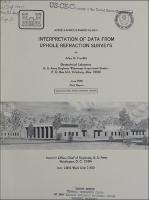Please use this identifier to cite or link to this item:
https://hdl.handle.net/11681/10143Full metadata record
| DC Field | Value | Language |
|---|---|---|
| dc.contributor.author | Franklin, A. G. (Arley G.) | - |
| dc.date.accessioned | 2016-06-20T13:52:52Z | - |
| dc.date.available | 2016-06-20T13:52:52Z | - |
| dc.date.issued | 1980-06 | - |
| dc.identifier.uri | http://hdl.handle.net/11681/10143 | - |
| dc.description | Miscellaneous Paper | - |
| dc.description | Abstract: The conventional interpretation of the data from an uphole refraction survey is based on the similarity between a plot of contours drawn on uphole arrival times and a wave-front diagram, which shows successive positions of the wave front produced by a single shot location at the ground surface. However, the two are alike only when the ground consists solely of homogeneous strata, oriented either horizontally or vertically. In this report, the term "Meissner diagram" is used for the plot of arrival times from the uphole refraction survey in order to maintain the distinction between it and a true wave-front diagram. Where departures from the case of homogeneous, horizontal strata exist, the interpretation of the Meissner diagram is not straightforward, although a partial interpretation in terms of a horizontally stratified system is usually possible. A systematic approach to the interpretation problem, making use of such a partial interpretation, is proposed. It consists of: (A.) determination of a tentative set of layer velocities and thicknesses on the basis of the wave-front interpretation; (B.) computation of theoretical travel times for the uphole refraction survey with these layer parameters; (C.) generation of an anomaly diagram by contouring the differences between observed and theoretical travel times; and (D.) identification of causative geological features by comparison with anomaly diagrams representing known or hypothesized geological conditions. Meissner diagrams and companion anomaly diagrams are presented for cases of subsurface cavities of different sizes in rock of different velocities, ridges and depressions on the bedrock surface, vertical offsets, dipping strata, and various errors of interpretation and measurement. Examples of field data from two sites are presented. Algorithms for computer generation of Meissner diagrams and anomaly diagrams are presented in Appendix A. On the basis of the studies described, it is concluded that the interpretation of uphole refraction data can be aided by the use of anomaly diagrams and that the nature of many geological features may be identified by comparison with anomaly diagrams representing hypothetical cases. While seismic travel times are affected by the presence of subsurface cavities and large cavities are identifiable, the sensitivity of the method is marginal for practical use in cavity detection. Some cavities large enough to be of engineering significance (e.g., a tunnel of 4-m diameter) may be practically undetectable by this method. | - |
| dc.publisher | Geotechnical Laboratory (U.S.) | - |
| dc.publisher | Engineer Research and Development Center (U.S.) | - |
| dc.relation | http://acwc.sdp.sirsi.net/client/en_US/search/asset/1042191 | - |
| dc.relation.ispartofseries | Miscellaneous paper (U.S. Army Engineer Waterways Experiment Station) ; GL-80-5. | - |
| dc.rights | Approved for public release; distribution is unlimited. | - |
| dc.source | This Digital Resource was created from scans of the Print Resource | - |
| dc.subject | Refraction | - |
| dc.subject | Uphole refraction | - |
| dc.subject | Seismic refraction | - |
| dc.subject | Seismic refraction method | - |
| dc.subject | Seismic surveys | - |
| dc.subject | Subsurface exploration | - |
| dc.subject | Seismology | - |
| dc.subject | Geophysical surveys | - |
| dc.title | Interpretation of data from uphole refraction surveys | - |
| dc.type | Report | en_US |
| Appears in Collections: | Miscellaneous Paper | |
Files in This Item:
| File | Description | Size | Format | |
|---|---|---|---|---|
| MP-GL-80-5.pdf | 9.06 MB | Adobe PDF |  View/Open |